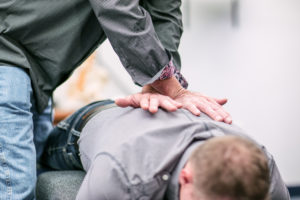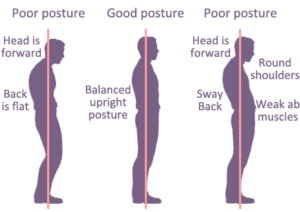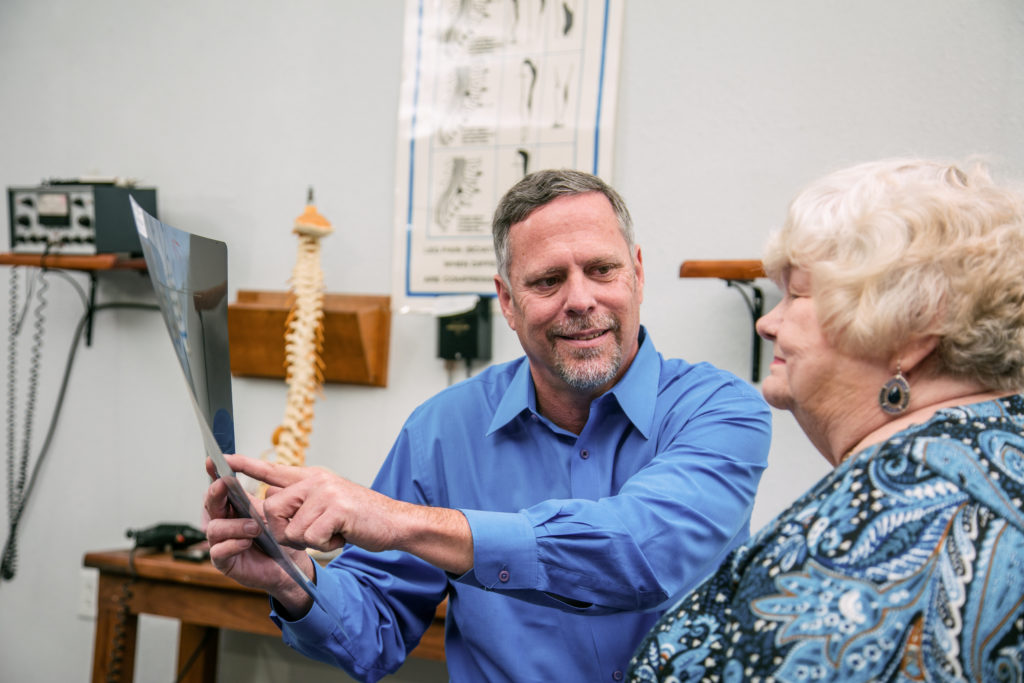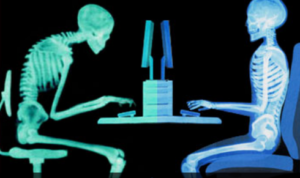Correcting Faulty Posture
Posture is essentially the position of the body in space.
 Optimal posture is the state of muscular and skeletal balance that protects the supporting structures of the body against injury or progressive deformity, whether at work or rest. Correct posture involves the positioning of the joints to provide minimum stress on the joints of the body. Increased stress can be compensated for by strong muscles, but if they are weak or the joints lack mobility
Optimal posture is the state of muscular and skeletal balance that protects the supporting structures of the body against injury or progressive deformity, whether at work or rest. Correct posture involves the positioning of the joints to provide minimum stress on the joints of the body. Increased stress can be compensated for by strong muscles, but if they are weak or the joints lack mobility
or are too mobile, joint wear can occur over time. As well, damage and changes to the surrounding tissues can happen, too.
Posture involves the chain-link concept of body mechanics in which problems anywhere along the body chain can lead to problems above or below that point. For example, knee pain can arise from pelvic joint disorders.
The effects of posture can be far reaching, involving respiratory, digestive, and circulatory systems as well as the musculoskeletal system.
How is poor or faulty posture developed?
The causes of poor posture can be divided into two categories: positional and structural. Structural causes are basically permanent anatomical deformities not amenable to correction by conservative treatments. Positional causes of poor posture include:
- poor postural habit–for whatever reason, the individual does not maintain a correct posture
- psychological factors, especially self-esteem
- normal developmental and degenerative processes
- pain leading to muscle guarding and avoidance postures
- muscle imbalance, spasm, or contracture
- respiratory conditions
- general weakness
- excess weight
- loss of proprioception–the ability to perceive the position of your body
Physiology of Posture
Posture control involves static and phasic reflexes. Static reflexes involve sustained contraction of the musculature while dynamic, short-term phasic reflexes involve transient movements. Both types of reflex are integrated at various levels in the central nervous system (CNS) from the spinal cord to the cerebral cortex and are largely effected through extrapyramidal motor pathways.
Postural reflex patterns from reflexes, such as the stretch and withdrawal reflexes, result in a coordination of many joint movements and combinations of muscle actions. These include contraction of prime movers, synergists, and stabilizers, along with the necessary relaxation of antagonists. These muscles are regulated for contraction intensity, speed, duration, and sequential changes in activity.
 The integrative pattern of posture is predominantly automatic and unconscious, resulting from the incessant shifting of weight (postural sway). Postural corrections are continuously mediated by the myotactic stretch reflex. Posture is further mediated by the visual, labyrinthine, neck-righting reflexes, and by the interplay of joint reflexes.
The integrative pattern of posture is predominantly automatic and unconscious, resulting from the incessant shifting of weight (postural sway). Postural corrections are continuously mediated by the myotactic stretch reflex. Posture is further mediated by the visual, labyrinthine, neck-righting reflexes, and by the interplay of joint reflexes.
While the control of posture is primarily controlled by various reflex mechanisms, there is also extensive input from the higher centers of the nervous system. Therefore, posture to some extent can be relearned (corrected) just as it was learned in the first place.
Correcting Postural Faults
A patient’s postural faults must be accurately diagnosed before they can be effectively corrected. Examination and diagnosis should include the following:
- observation of the patient as they sit and move about
- measurement or estimation of the deviation from ideally erect postures using plumb lines, inclinometry, and posture guides
- three-dimensional analysis
- spinal segmental alignment
- flexibility tests
- muscle length and strength tests
The importance of muscle testing to postural analysis cannot be over-emphasized. Also, much of the specific therapy in posture correction relies directly on muscle tightness and weakness found during the examination.
Conventional Corrective Therapies
Five main modalities are employed in the conventional treatment of faulty body mechanics and hence postural faults: heat; massage; stretching; strengthening exercises; and supportive measures to treat ligaments, bones, and nerves.
Shortened agonist muscles must be stretched before the antagonist muscles can be optimally exercised to increase their strength, or vice versa. Depending on the condition, manipulation may also be required to release an accompanying fixation. Therefore, manipulation should be added to the list of posture correction therapies.
(Thanks to Advance Chiropratic for the information above.)
Testimonials
"Before I came to see Dr. Sammy I could hardly bend, and now that I have been to Dr. Sammy I can bend over, I can touch my toes. He has definitely improved my quality of life. I owe so much to him. He will definitely change your life."
Brenda Davis
"I came to him to get help with my allergies. At first I was a little skeptical because you think how can a chiropracter help with allergies, right? He has these little wands that give me pressure where my sinuses are. He gives me electronic acupuncture. It really really helps keep my sinuses clear and I use to have to take allergy medicine every single day; and in the springtime more than once a day, and now I have probably taken three all year. He’s really helped me tremendously."
Carol Short
"I came to see Dr. Sammy because I had a significant difficulty with one of my shoulders. It was a very painless process, it worked very quickly. We were done in four to five minutes each time and within a very short period of time—two or three weeks—in my particular case, I started to see significant improvements in mobility and so it’s been a great experience for me."
Ed Balli
"Two days ago I fell and hurt my right shoulder and I literally couldn’t use my arm, I came to Sammy yesterday and then I came back again today and I can actually use my arm now. Thank you Dr. Sammy."
Nancy Trice
"I was in an accident in November and started chiropractic care because of excessive pain in my back and neck. I have had back pain off and on since I was a teenager due to Scoliosis, an abnormal lateral curvature of the spine and I would take the pain killer Advil as needed. After several visits, I am pain free right now. I can now continue working out at the gym 4 days a week and maintain a better quality of life and I owe it all to Dr. Sammy Hardin."
Jeff Postell
"I own a dog grooming shop and groom full time. This involves a lot of lifting. I also have horses that I like to work and have fun with. Both of these activities requires a lot of arm and shoulder strain. I have frequently, for the last 25 years, pulled a muscle in my lower back. Even though I could barely lift my left arm because of the pain I had for 5 months, it was ultimately the pull in my lower back that brought me to see Dr. Hardin in March. Up until this time it was a chore to just put my horses in their stalls to feed them let alone do anything fun with them. After a couple of treatments my back was a lot better. just a couple of months later, one day I realized my arm wasn’t hurting either! Now I feel like going out in the barn to play with my horses again. Thanks to you, Dr. Hardin."
Sharon
Hablamos Español
We accept ALL major insurance, PI, Auto, LOP, Medicare
No insurance? NO problem. We offer affordable cash pay.

New Patient Special, Only $50
New Patient Special Includes Your:
- Initial Consultation
- Comprehensive Exam
- Two Chiropractic Adjustments
- Report of Findings

